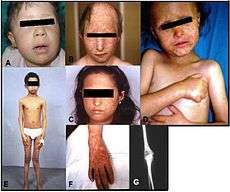Rothmund–Thomson syndrome
| Rothmund-Thomson syndrome | |
|---|---|
 Panel showing some clinical features of the RTS syndrome. A) Chronic phase of cheek poikiloderma (4-year-old girl). B) Poikiloderma with alopecia (21-year-old boy). C) Poikiloderma. D) Poikiloderma sparing the trunk (courtesy of Professor M. Paradisi, Rome). E) Photo distributed poikiloderma and valgism of the knees. F) Thumb aplasia (patient B). G) Bone defect seen by X-Rays: cystic-like destructive lesion of the humerus (distal epiphysis) without apparent solution of continuity of the cortical bone (patient E). | |
| Classification and external resources | |
| Specialty | medical genetics |
| ICD-10 | Q82.8 (ILDS Q82.852) |
| ICD-9-CM | 757.33 |
| OMIM | 268400 |
| DiseasesDB | 29891 |
| eMedicine | derm/379 |
| MeSH | D011038 |
| GeneReviews | |
| Orphanet | 2909 |
Rothmund–Thomson syndrome (RTS), also known as poikiloderma atrophicans with cataract or poikiloderma congenitale,[1][2] is a rare autosomal recessive[3][4] skin condition originally described by August von Rothmund (1830–1906) in 1868. Matthew Sydney Thomson (1894–1969) published further descriptions in 1936.[5]
There have been several reported cases associated with osteosarcoma. A hereditary genetic basis, mutations in the DNA Helicase RECQL4 gene, causing problems during initiation of DNA replication has been implicated in the syndrome [1][6][7][8]
Characteristics
- Sun-sensitive rash with prominent poikiloderma and telangiectasias
- Juvenile cataracts
- Saddle nose
- Congenital bone defects, including short stature and radial ray anomalies such as absent thumbs
- Hair growth problems (absent eyelashes, eyebrows and/or hair)
- Hypogonadism has not been well documented
- Hypodontia
- Calcium problems (not documented in journals)
- Ear problems (not documented in journals but identified by patients in support groups)
- Produces Osteosarcoma[9]
The skin is normal at birth. Between 3 to 6 months of age, the affected carrier develops poikiloderma on the cheeks. This characteristic “rash” that all RTS carriers have can develop on the arms, legs and buttocks. “Poikiloderma consists of areas of increased and decreased pigmentation, prominent blood vessels, and thinning of the skin”[10]
Cause and Genetics

RTS is caused by a mutation of the RECQL4 gene, located at chromosome 8q24.3.[6][11] The disorder is inherited in an autosomal recessive manner.[3] This means the defective gene responsible for the disorder is located on an autosome (chromosome 8 is an autosome), and two copies of the defective gene (one inherited from each parent) are required in order to be born with the disorder. The parents of an individual with an autosomal recessive disorder both carry one copy of the defective gene, but usually do not experience any signs or symptoms of the disorder.
See also
- Poikiloderma vasculare atrophicans
- List of cutaneous conditions
- List of radiographic findings associated with cutaneous conditions
References
- 1 2 Online 'Mendelian Inheritance in Man' (OMIM) 268400
- ↑ James, William; Berger, Timothy; Elston, Dirk (2005). Andrews' Diseases of the Skin: Clinical Dermatology (10th ed.). Saunders. p. 576. ISBN 0-7216-2921-0.
- 1 2 Larizza, L.; Roversi, G.; Volpi, L. (Jan 2010). "Rothmund-Thomson syndrome". Orphanet Journal of Rare Diseases (Free full text) 5: 2. doi:10.1186/1750-1172-5-2. PMC 2826297. PMID 20113479.
- ↑ Raza N, Malik QU, Hussain Z (2007). "Rothmund-Thomson syndrome: more than just a cosmetic concern". J Coll Physicians Surg Pak. 17 (7): 423–424. PMID 17686357.
- ↑ Thomson, MS. (Mar 1936). "Poikiloderma Congenitale: Two Cases for Diagnosis.". Proc R Soc Med 29 (5): 453–5. PMID 19990626.
- 1 2 Larizza L, Magnani I, Roversi G (January 2006). "Rothmund–Thomson syndrome and RECQL4 defect: Splitting and lumping". Cancer Letters 232 (1): 107–120. doi:10.1016/j.canlet.2005.07.042. PMID 16271439.
- ↑ Hicks MJ, Roth JR, Kozinetz CA, Wang LL (2007). "Clinicopathologic features of osteosarcoma in patients with Rothmund-Thomson syndrome". J. Clin. Oncol. 25 (4): 370–5. doi:10.1200/JCO.2006.08.4558. PMID 17264332.
- ↑ Sangrithi MN, Bernal JA, Madine M, Philpott A, Lee J, Dunphy WG, Venkitaraman AR (Jun 2005). "Initiation of DNA replication requires the RECQL4 protein mutated in Rothmund-Thomson syndrome". Cell 121 (6): 887–98. doi:10.1016/j.cell.2005.05.015. PMID 15960976.
- ↑ Wang LL, Levy ML, Lewis RA, et al. (2001). "Clinical manifestations in a cohort of 41 Rothmund-Thomson syndrome patients". Am. J. Med. Genet. 102 (1): 11–17. doi:10.1002/1096-8628(20010722)102:1<11::AID-AJMG1413>3.0.CO;2-A. PMID 11471165.
- ↑ Understanding RTS pamphlet, RTS Team: Lisa L. Wang (Oncologist), Moise L. Levy (dermatologist), Richard A. Lewis (Ophtalmologist), Sharon E. Plon (Geneticist)
- ↑ Online 'Mendelian Inheritance in Man' (OMIM) 603780
External links
- Rothmund-Thomson on PFOND - web-based service to promote the sharing of information about research, treatment and resources for rare genetic disorders.
- GeneReviews/NCBI/NIH/UW entry on Rothmund-Thomson Syndrome
- Poikiloderma of Rothmund-Thomson at NIH's Office of Rare Diseases
- RTSPlace.org
| ||||||||||||||||||||||||
| ||||||||||||||||||||||||